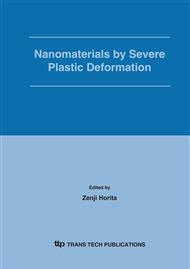p.341
p.349
p.355
p.363
p.371
p.379
p.385
p.391
p.399
Scaling up of Equal Channel Angular Pressing (ECAP) for the Production of Forging Stock
Abstract:
Over the past two decades equal channel angular processing (ECAP) and other severe plastic deformation (SPD) processes have been shown, in the laboratory scale, to produce material with promising properties for industrial applications. In particular, ultrafine grain (UFG) metals produced by ECAP process, for example, have been shown to exhibit higher strain rate sensitivity at lower temperatures and higher strain rates. These factors translate to improved hot formability. However, scale up of these processes to manufacture industrial size components has not been widely undertaken. In this study, billets of annealed AA6061 with 12.5 mm (0.5-in), 50 mm (2-in) and 100 mm (4-in) square cross section were ECAP processed. For the first time, these larger SPD billets were used as starting stock for subsequent hot forging. Several parts were forged on an industrial scale press with the UFG material, as well as conventional stock materials. These parts varied in complexity, as well as size in order to cover the variability in industrial components. This paper will present the effect of scaling up on the mechanical properties, microstructure, and the hot workability of the alloy from the laboratory scale (12.5 mm) to industrial scale (100 mm). Results show that both the forging temperature of the billets and the starting billet size can be substantially decreased compared to conventional forging practice. Therefore, the use of SPD materials, as forging stock, results in decreased energy usage and increased material yield. Results presented will include examples of forged parts, estimated energy savings associated with the use of SPDUFG stock, and properties after forging and subsequent heat treatment.
Info:
Periodical:
Pages:
371-378
Citation:
Online since:
January 2006
Authors:
Price:
Сopyright:
© 2006 Trans Tech Publications Ltd. All Rights Reserved
Share:
Citation:


